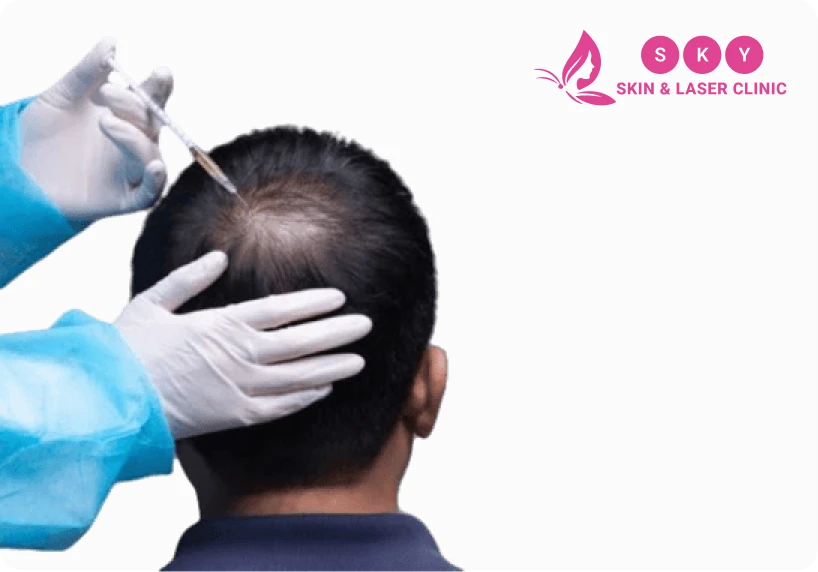WHAT IS PRP HAIR TRANSPLANT AND ITS ADVANTAGES?

Table of Contents
PRP Hair transplant are now commonly performed in one large session or multiple procedures over a period of weeks or months. The final session collects hair follicles from the donor spot on the back of the patient’s head, completing the process. For some people, such as those with medical issues, many sessions may be a preferable option.
Within 3 to 6 months following transplantation, the majority of the transplanted follicles will develop and create hair in their new place. In their new environment, some transplanted follicles do not grow.
PRP treatment was developed as a technique to improve the survival of transplanted hair follicles and accelerate healing with minimal trauma following transplantation. There is a growing corpus of research on the use of platelet-rich plasma (PRP) in hair growth after hair transplantation, as well as in a variety of other medical and surgical specialties to increase tissue repair and healing following surgery or damage.
What is PRP?
Platelet Rich Plasma (PRP) is blood plasma with platelet densities that are several times greater than normal. PRP is autologous, meaning it is derived from the patient’s own blood. Prior to surgery, patients donate blood.
How Is PRP Made?
- As with any laboratory operation, blood is extracted from the patient's hand with a syringe.
- A centrifuge is used to spin the tube containing the blood obtained for a period of time.
- Centrifugation rotates red and white blood cells and platelets, concentrating them at different levels in the tube. A sample of platelet-rich blood plasma is obtained from the relevant location. Platelet-rich plasma varies from regular plasma in that it includes 4 to 8 times the amount of platelets per cubic centimeter. PRP is ready for injection with a little more preparation.
PRP for hair transplantation:
- Increasing the strength of impoverished donors and non-transplanted areas
- Increasing the production of transplanted grafts
- lowering the rate of transactional graft
- Both the donor and recipient sites are being healed.
Advantages of PRP after Hair Transplant:
The advantages of using PRP to improve hair healing and growth after hair transplantation are divided into three categories:
- Hair follicle vitality during and after hair transplantation is maintained and increased.
- Promote and accelerate tissue regeneration and recovery following hair transplantation.
- To encourage new hair growth and strengthen dormant hair follicles.
Procedure of PRP Hair Transplant
PRP hair transplant is a three-step technique that takes roughly three to seven weeks to complete. Furthermore, every four to six months, maintenance treatments are required. Let’s have a look at the steps of the therapy.
- Blood is drawn from the arm and placed in specially designed nutrients-enriched test tubes, which are then placed in a centrifuge machine to separate fluids of different densities.
- The blood is split into three layers after roughly ten minutes in the machine: platelet-rich plasma, platelet-poor plasma, and red blood cells.
- The surgeons extract platelet-rich blood into a syringe, activate it with specific solutions, and inject it into the areas of the scalp where more hair growth is needed in this stage.
Promote and enhance tissue repair and healing:
The release of platelet growth factors at the site of tissue injury, which encourages tissue repair and healing, is one of the activities that promote tissue repair and healing following injury and surgery. Surgeons have employed individual growth factors like PDGF platelet-derived growth factors to improve wound healing in hospitalized surgical patients. PRP is used in outpatient hair transplantation to take advantage of a variety of platelet-related growth factors:
- To boost the healing process
- Scarring should be minimized.
- Encourage optimum hair growth in follicles that have been transplanted.
Injecting PRP gel into the wound during wound closure is one approach of administering PRP to the scalp incision. Doctors that use this method report that the graft site heals faster.
Strengthen hair follicles and to stimulate new hair growth:
PRP stimulates hair growth after transplantation, as we all know. Platelet growth factors, on the other hand, can reactivate dormant hair follicles and stimulate the creation of new hair. PRP is used to encourage platelets to release growth factors at the site of injury after the scalp skin has been slightly wounded. In the next four months, you’ll notice an increase in hair growth and diameter.
Differences Between PRP Hair Therapy and FUE Hair Transplant
- PRP therapy is less invasive because shallow injections are utilized, while FUE necessitates very small incisions.
- PRP therapy activates hair follicles in their current location, whereas FUE redistributes active hair follicles.
- The effects of PRP therapy are relatively minor, whereas FUE can make a significant difference in a person's look.
- In comparison to FUE hair transplantation, PRP therapy takes less time and requires less aftercare.
- PRP therapy is available to almost anyone who wants to improve their scalp health and hair, however FUE is not for everyone.
- PRP therapy is less expensive, but FUE demands a significant investment.
Conclusion
Injecting a higher concentration of platelets into the scalp after PRP hair transplant speeds up the healing process while also rejuvenating the cells. PRP is combined with hair transplants by the doctors at Sky Skin and Laser Clinic in chennai, which is a better choice because you will profit in the long run. PRP is also a fantastic choice if you have hair loss in a region that hasn’t been transplanted.
PRP fights hair loss, and many people believe it’s a safe and efficient technique to stop hair loss and promote new hair growth.
Consulting the doctor to determine which treatment or combination of treatments is best for you. Quality and result-oriented Platelet-Rich Plasma PRP Hair Transplant is offered in Sky skin and laser Clinic by the best dermatologist in Chennai if you want to know more about PRP scalp care after a hair transplant or want to undergo the procedure.

With over 12 years of expertise, Dr. Chithra, M.B.B.S., D.D.V.L., honed her dermatology skills at Madras Medical College, attending 100-200 patients daily. Her experience and expert skills in dermatology & cosmetology makes Sky Skin & Laser clinic Chennai as go-to place for comprehensive skin and hair care.
Read MoreRecent Posts
- Why Bridal Treatments Should Start with a Dermatologist?
- Botox Injections for Under Eyes: All You Need to Know About
- Underarm Botox: Benefits for All-Day Freshness
- How Can Botox Help Smooth Away Fine Lines and Wrinkles?
- The Ultimate Guide to Botox Treatment for Forehead Lines
- Unlocking Youthful Radiance: The Benefits of Botulinum Toxin (Botox) Treatments
- How Laser Upper Lip Hair Removal Provides Long-Term Solutions?
- Choosing the Right Dermatologist for Permanent Hair Removal
- Facial Hair Removal: Why Dermatologist-Administered Treatments Are Your Best Option?
- Laser Hair Removal: Ultimate Solution for Smooth Underarms
- Laser Hair Removal: Ultimate Guide Before Booking Appointment
- How Skin Lightening Treatments Improve Overall Skin Health?
- Safe Skin Bleaching: Navigating Risks Effectively
- Dermatologist’s Skin Whitening Facials: Expert Guidance
- Dermatologist’s Role in Effective Pimple Treatment
- Boost Confidence: Dermatological Solutions for Pimple Marks
- Forehead Acne: Dermatologist Insights for Treatment
- Laser Treatment:Prevent Acne Scarring, Preserve Skin Texture
- Transform Uneven Tone: Chemical Peels for Radiant Skin
- Lip Chemical Peel Treatments: Your Key to Softer, Smoother Lips
- Exploring the Effectiveness of Chemical Peels for Dark Circles
- What You Need to Know Before Your Chemical Peel Appointment?
- Laser Toning Treatment: An Ideal Procedure for Pigmentation
- Pigmentation Battles: Transforming Skin with Facial Treatments
- Unveiling the Top Dermatologists in Chennai
- All You Need To Know About Laser Tattoo Removal Treatment – Sky Skin and Laser Clinic
- How Microdermabrasion Can Improve Your Skin?
- HydraFacial Treatments: Benefits, Side Effects, and Cost – Sky Skin Clinic
- Laser Hair Removal Treatment- it is Permanent, Safe, and the best solution
- Microneedling -Taking Your Skin Care To a New Level – Sky Skin and Laser Clinic | Best Dermatologist in Chennai
- Skin Laser treatment to Reduce Loose Skin and Wrinkles – Sky Skin Laser Clinic
- Tips For Having A Clear And Glowing Skin – Sky Skin and Laser Clinic
- Top Interesting Laser Hair Removal Facts – Sky Skin and Laser Clinic
- Acne Scars: What Causes Them and How to Avoid Them
- What is PRP Hair Transplant and its Advantages?
- How to remove unwanted hair easily without pain and permanently?
- How Stress Affect Your Skin?
- How To Keep Your Skin Soft, Smooth And Healthy?
- What Are The Reason & Best Treatments For Hair Loss & Dandruff?
- How To Get Rid Of Acne Scars And Marks From The Face?
For Appointments
Got Questions ? We are here for you
Reach Out Today, We're Responsive!
Fill the Form Below to Address Your Skin Concerns.

Quick Links
Quick Links
You cannot copy content of this page


